PHOENIX — Homeless in America’s hottest big metro, Stefon James Dewitt Livengood was laid out for days inside his makeshift dwelling, struggling to breath, nauseous and vomiting.
Every day this month, temperatures have soared past 110 degrees Fahrenheit.
Livengood said he stopped briefly at a free clinic that took his blood pressure and declared it acceptable. But he received no other medical help for his apparent heat exhaustion, or for the peeling skin on his arms he believes was caused by sun exposure. He is careful when he walks through the sprawling tent city, cognizant that if he falls, the simmering black asphalt could seriously burn his skin.
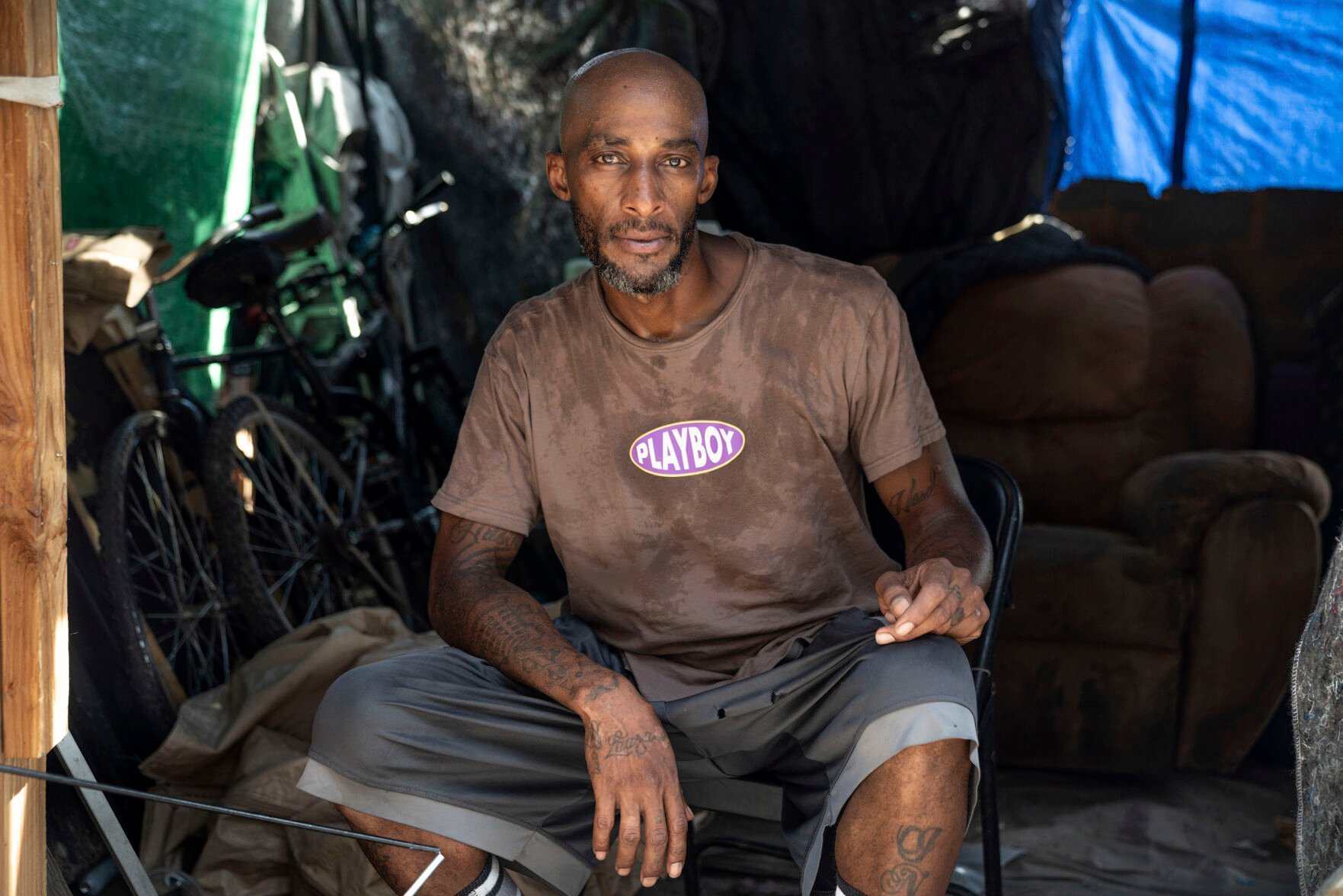
Thomas Machowicz, Associated Press
Stefon James Dewitt Livengood sits in the tent where he lives July 23 in Phoenix.
“If you’re going outside, let somebody know where you’re going so you can be tracked so you don’t pass out out there,” he said. “If you fall out in the heat, you don’t want a third-degree burn from the ground.”
The 38-year-old sleeps in a structure cobbled together with a frame of scavenged wood and metal covered by blue vinyl tarp. The space inside is large enough to stand up and walk around in and features an old recliner and a bicycle Livengood uses less now that he spends more time inside with the sides of his dwelling open.
“Some of the friends that I’ve made down here, they come check on me if they don’t see me moving around,” he said.
Homeless people are among those most likely to die in the extreme heat in metro Phoenix. The city is seeing its longest run of consecutive days of 110-degree weather ever recorded, clocking 28 in a row as of Thursday, even as the first monsoon storm of the season brought some overnight relief.
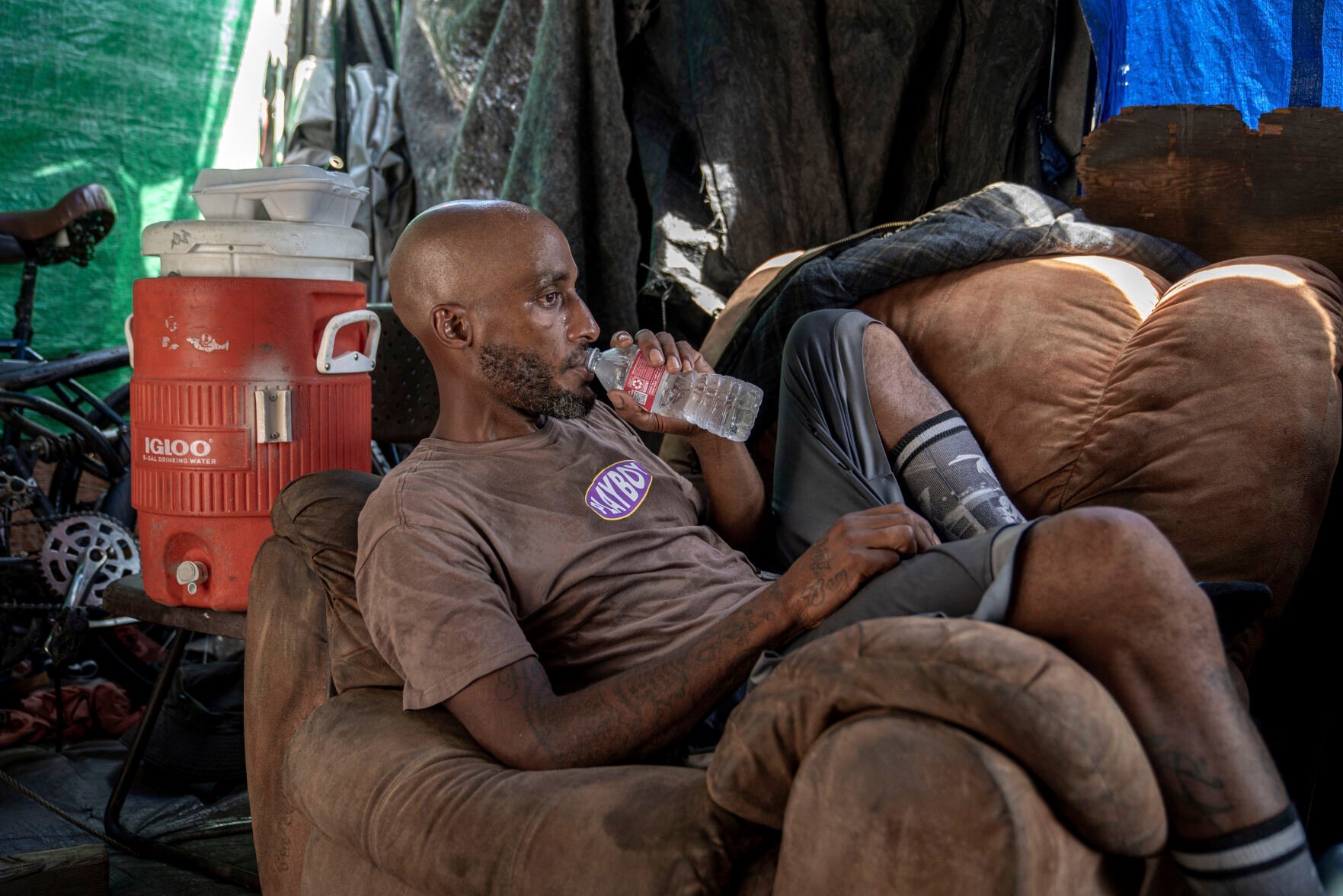
Thomas Machowicz, Associated Press
Stefon James Dewitt Livengood drinks water July 23 in his tent where he lives in Phoenix amid a record-breaking heat wave.
“It has been a scary situation this year and it’s especially scary for our homeless population,” said Dr. Geoff Comp, an emergency room physician for Valleywise Health in central Phoenix. “They have a more constant exposure to the heat than most of us.”
People living outside are also vulnerable to surface burns from contact with hot metal, concrete or asphalt.
Surgeons at the Arizona Burn Center–Valleywise Health recently warned about burns caused by walking, sitting or falling on outside surfaces reaching up to 180 degrees. The burn center last year saw 85 people admitted with heat-related surface burns for the months of June through August. Seven died.
Record high overnight temperatures persisted above 90 degrees for 16 days straight after finally slipping to 89 on Thursday after a storm Wednesday evening kicked up dust, high winds and a bit of rainfall.
If temperatures don’t drop sufficiently after the sun sets, it’s hard for people’s bodies to cool down, health professionals say, especially those who live in flimsy structures without air conditioning or fans.
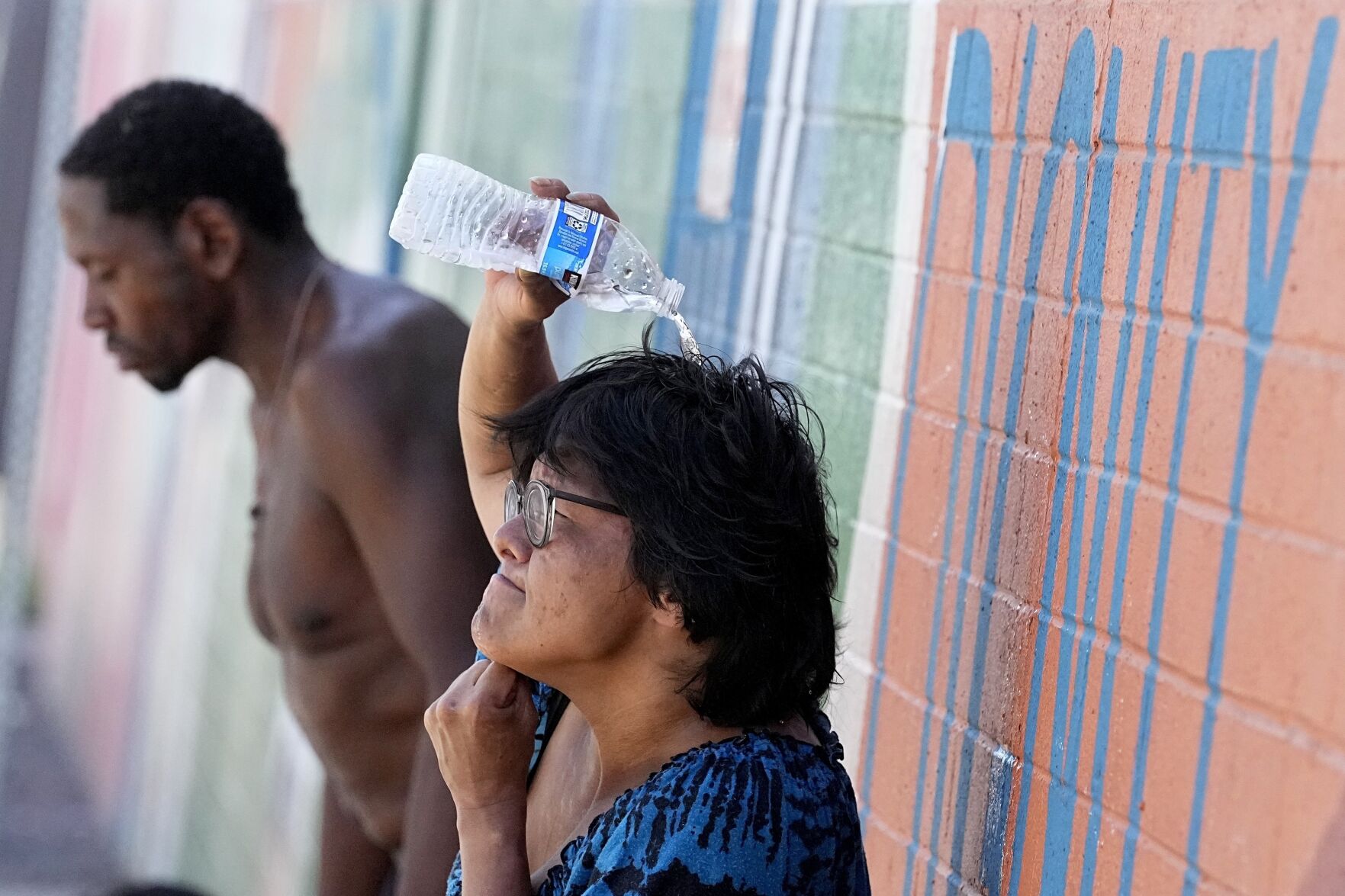
Matt York, Associated Press
People who are homeless try to cool down with chilled water July 14 outside the Justa Center, a day center for homeless people 55 years and older in downtown Phoenix. Homeless people are among the people most likely to die in the extreme heat.
“People really need a lot of water and a cooling system to recover overnight,” Comp said.
There is no air conditioner, fan or even electricity in Livengood’s home, just a little, flat piece of plastic he uses as a hand fan.
Unhoused people accounted for about 40% of the 425 heat-associated deaths tallied last year in Maricopa County, home to Phoenix, during its hottest summer on record. More than half of the 425 deaths occurred in July and 80% occurred outdoors.
Maricopa County reported Wednesday that as of July 22, there were 25 heat-associated deaths confirmed this year going back to April 11. Another 249 deaths remain under investigation.
Livengood’s shack stands among some 800 people living in tents and other makeshift dwellings outside Arizona’s largest temporary shelter. The tents stand close together on concrete sidewalks, and seem to increase the stifling heat from the encampment called “The Zone.”
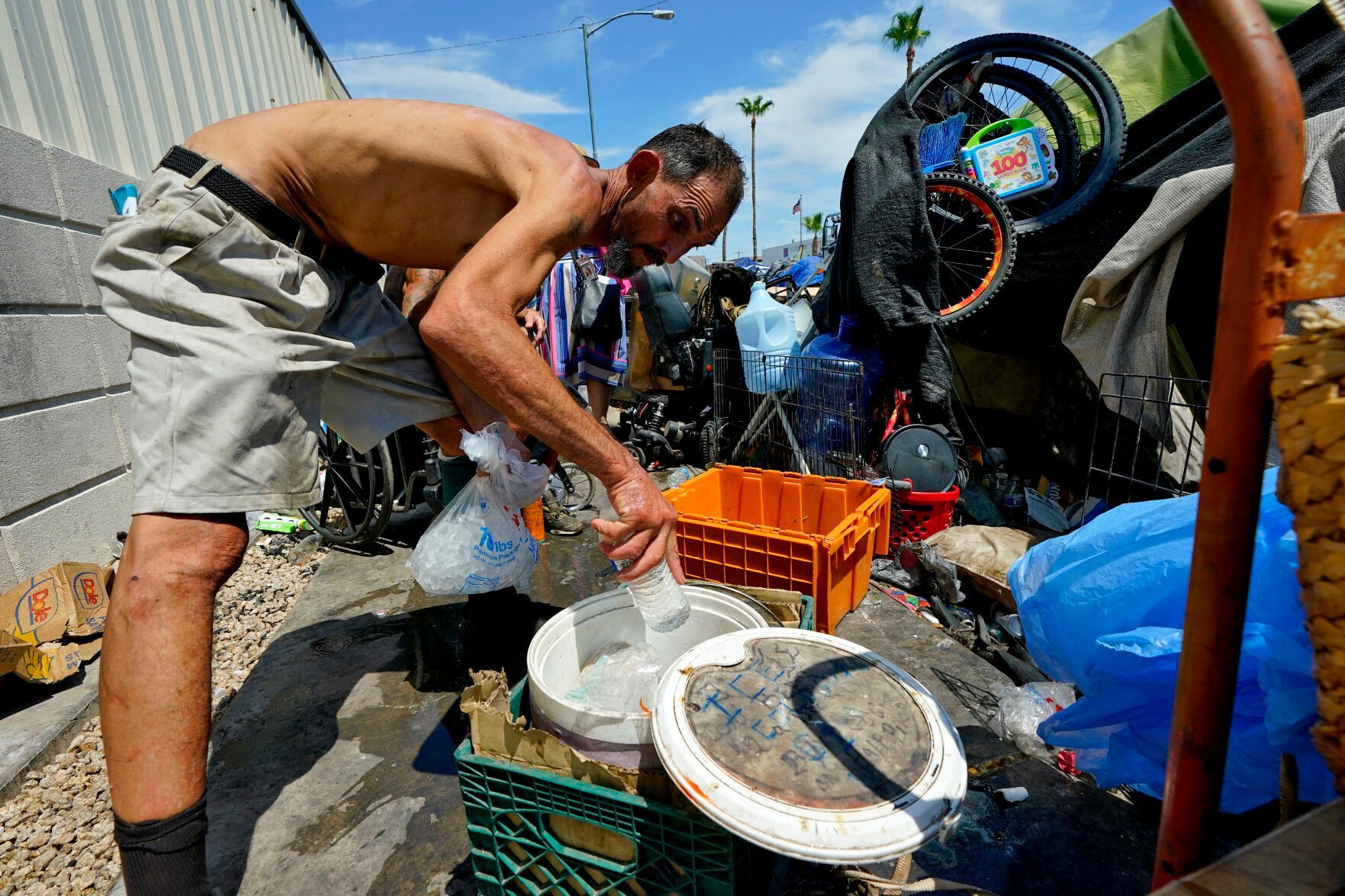
Matt York, Associated Press
Kevin Hendershot pours ice into a bucket outside his tent July 14 in "The Zone," a homeless encampment in downtown Phoenix. Hendershot spends his days in the Justa Center, a day center for homeless people 55 years and older in the downtown area.
But the location is convenient. Nearby agencies provide social services, food and life-saving water, including the Society of St. Vincent de Paul, the Boys and Girls Club, the YMCA and St. Mary’s Food Bank.
Livengood can get breakfast and lunch with faith-based groups in the area before taking a nap in his recliner.
On some hot days, the local transportation agency Valley Metro send over a couple of empty buses so people can sit for hours in the air conditioning. On other days, Livengood and a few friends walk to a nearby city park and sit in the grass under shade trees outside a public swimming pool.
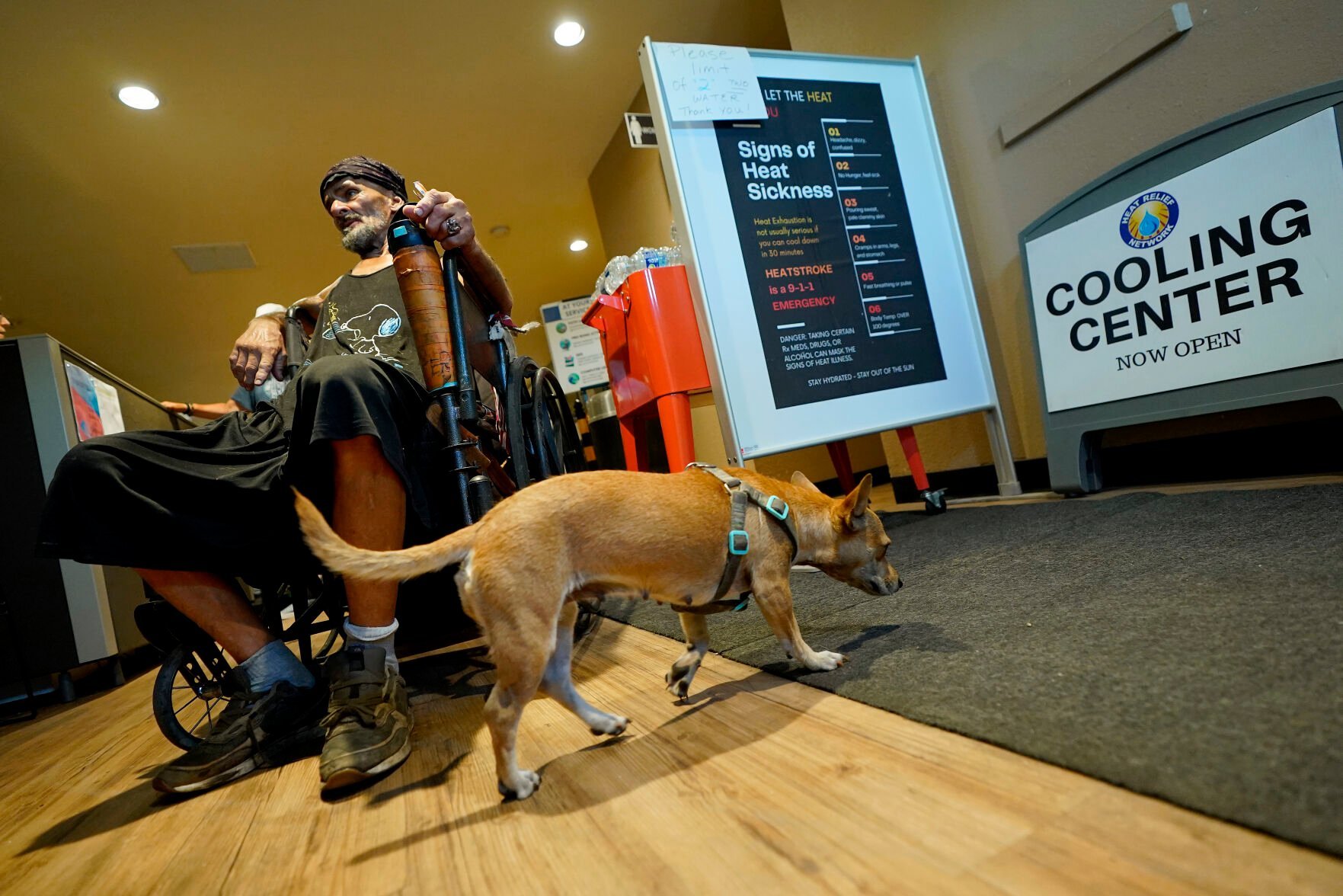
Matt York, Associated Press
Charles Sanders, 59, and his dog Babygirl cool off July 14 inside the Justa Center in downtown Phoenix, which is seeing its longest run of consecutive days of 110 degree Fahrenheit ever recorded.
“It’s a definite part of what keeps everybody safe down here in the ‘The Zone,’” Livengood said, ticking off the things people distribute: hygiene items, sunscreen, lip balm, hats and cooling rags. “A lot of love is given out here.”
Livengood tells of a childhood of trauma and neglect. Born in Phoenix and originally named Jesse James Acosta Jr., Livengood spent much of his early years in public housing in a low-income, largely African American neighborhood of south Phoenix. Both of his parents spent time in prison. His mother struggled with addiction, giving birth to a daughter behind bars, and later slipped into homelessness.
“My childhood has been filled with a lot of memories of being bounced around, never really having anything stable,” Livengood said.
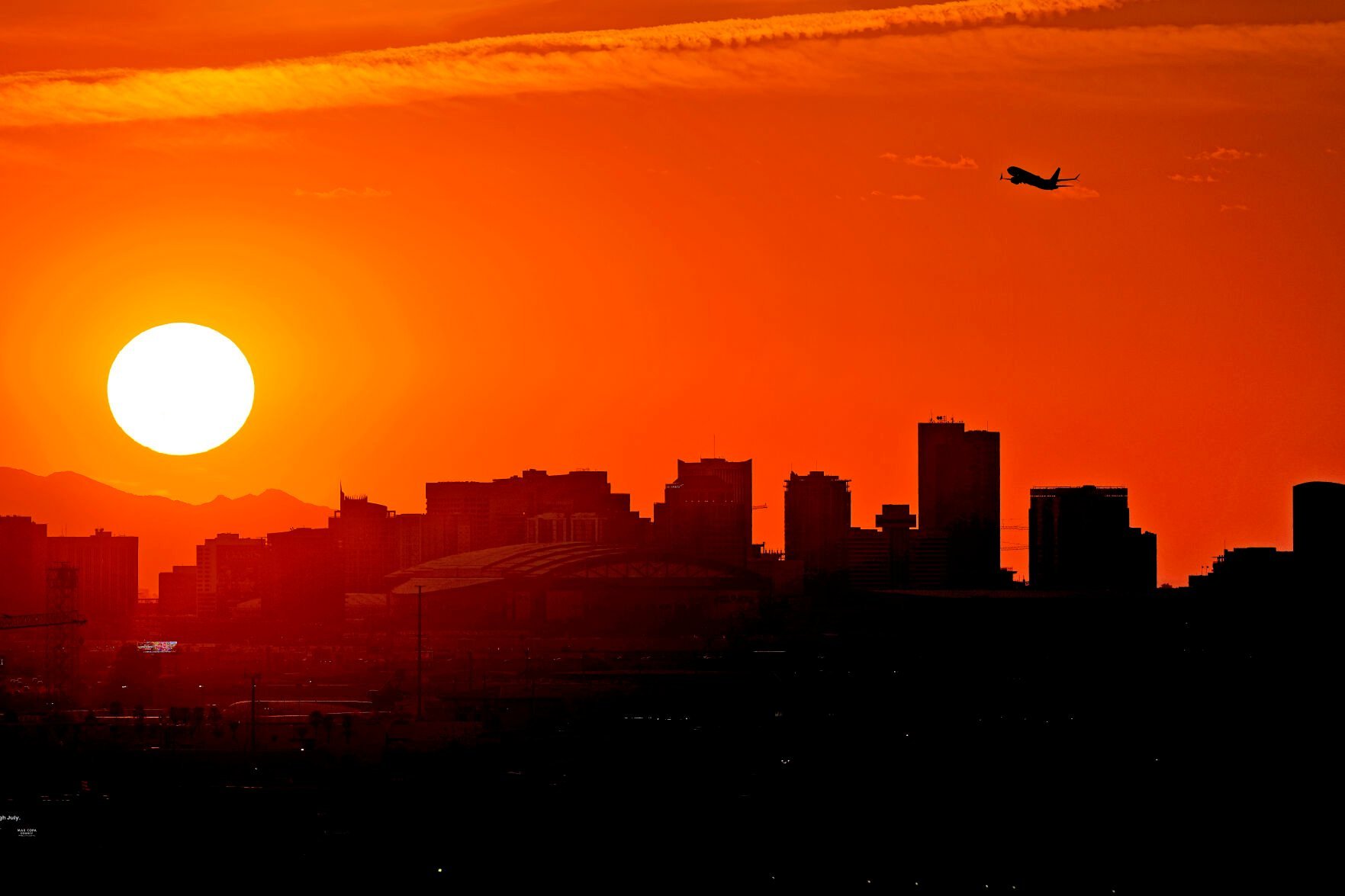
Matt York, Associated Press
A jet takes flight from Sky Harbor International Airport as the sun sets July 12 over Phoenix.
Livengood was adopted at age 12 by a woman named Denise who legally changed his name to the current one. He and the rest of his adoptive family moved to Alaska, where his adoptive mother died in a traffic accident.
Livengood struggled in school and met the mother of his son. He later left behind the woman and their child to return to Phoenix, a decision he regrets.
Back in the desert, Livengood said he is well aware of the dangers from extreme heat from the pamphlets volunteers pass out with bottles of icy water.
“Yeah, it gets really hot out here, guys,” he said. “Stay hydrated, drink plenty of water even when you think you’ve had a lot of water. And drink more.”
-
Homeless struggle to stay safe from blistering heat in America’s hottest big metro
Keep Smiling Photography // Shutterstock
Homelessness is a prominent issue affecting many cities and all racial and ethnic groups across the United States. About 18 in every 10,000 U.S. residents experienced homelessness in 2022, according to the 2023 "State of Homelessness" report by the National Alliance to End Homelessness.
The Department of Housing and Urban Development has a multipartite definition of homelessness, by which a person is considered to be experiencing homelessness when they lack a "fixed, regular, and adequate nighttime residence," including those staying at temporary shelters, transitional housing, or places not intended for dwelling. The definition also includes persons at risk of imminent loss of their homes with no support networks or alternative housing options to provide them a roof over their heads.
The primary causes of homelessness in the U.S. include a shortage of affordable housing, low income and unemployment, physical and mental health challenges, and domestic violence, according to the National Alliance to End Homelessness.
Using the HUD's 2022 Annual Homeless Assessment Report, Stacker has compiled a list of statistics and facts about homelessness in the U.S.

Keep Smiling Photography // Shutterstock
Homelessness is a prominent issue affecting many cities and all racial and ethnic groups across the United States. About 18 in every 10,000 U.S. residents experienced homelessness in 2022, according to the 2023 "State of Homelessness" report by the National Alliance to End Homelessness.
The Department of Housing and Urban Development has a multipartite definition of homelessness, by which a person is considered to be experiencing homelessness when they lack a "fixed, regular, and adequate nighttime residence," including those staying at temporary shelters, transitional housing, or places not intended for dwelling. The definition also includes persons at risk of imminent loss of their homes with no support networks or alternative housing options to provide them a roof over their heads.
The primary causes of homelessness in the U.S. include a shortage of affordable housing, low income and unemployment, physical and mental health challenges, and domestic violence, according to the National Alliance to End Homelessness.
Using the HUD's 2022 Annual Homeless Assessment Report, Stacker has compiled a list of statistics and facts about homelessness in the U.S.

-
Homeless struggle to stay safe from blistering heat in America’s hottest big metro
Matt Gush // Shutterstock
According to the HUD report, more than 50% of individuals experiencing homelessness in the U.S. were located in California, New York, Florida, and Washington, as of 2022. In California alone, the number of people considered unsheltered (in other words, those experiencing homelessness who aren't in shelters or transitional housing) exceeded half that of those who are unsheltered in the rest of the country combined. California's unsheltered population is ninefold that of Washington's—the state with the second-highest number of unsheltered people as of 2022.
Matt Gush // Shutterstock
According to the HUD report, more than 50% of individuals experiencing homelessness in the U.S. were located in California, New York, Florida, and Washington, as of 2022. In California alone, the number of people considered unsheltered (in other words, those experiencing homelessness who aren't in shelters or transitional housing) exceeded half that of those who are unsheltered in the rest of the country combined. California's unsheltered population is ninefold that of Washington's—the state with the second-highest number of unsheltered people as of 2022.
-
-
Homeless struggle to stay safe from blistering heat in America’s hottest big metro
Peyker // Shutterstock
The year 2020 marked the start of the COVID-19 pandemic and lockdowns in the U.S. Unemployment steeply increased following the lockdowns as businesses shut down and companies began laying off workers, according to the Bureau of Labor Statistics. With unemployment being among the primary causes of homelessness, there was, expectedly, an increase in people experiencing homelessness in the U.S. That said, the federal eviction moratorium did help prevent a drastic rise in homelessness in the country due to people falling behind on rent payments.
Peyker // Shutterstock
The year 2020 marked the start of the COVID-19 pandemic and lockdowns in the U.S. Unemployment steeply increased following the lockdowns as businesses shut down and companies began laying off workers, according to the Bureau of Labor Statistics. With unemployment being among the primary causes of homelessness, there was, expectedly, an increase in people experiencing homelessness in the U.S. That said, the federal eviction moratorium did help prevent a drastic rise in homelessness in the country due to people falling behind on rent payments.
-
Homeless struggle to stay safe from blistering heat in America’s hottest big metro
Linda Hughes Photography // Shutterstock
President Obama's administration unveiled an ambitious plan called "Opening Doors: Federal Strategic Plan to Prevent and End Homelessness" in 2010. The program aimed to reduce homelessness among people who chronically experienced it—including veterans—by 2020, according to the National Coalition for the Homeless. The plan's implementation, the 2009 Homeless Emergency Assistance and Rapid Transition to Housing Act, and the U.S. recovery from the 2008 recession are likely to have contributed to the decrease in homelessness since 2010, along with the aforementioned eviction moratorium that stalled a sharp rise of homelessness at the start of the pandemic.
Linda Hughes Photography // Shutterstock
President Obama's administration unveiled an ambitious plan called "Opening Doors: Federal Strategic Plan to Prevent and End Homelessness" in 2010. The program aimed to reduce homelessness among people who chronically experienced it—including veterans—by 2020, according to the National Coalition for the Homeless. The plan's implementation, the 2009 Homeless Emergency Assistance and Rapid Transition to Housing Act, and the U.S. recovery from the 2008 recession are likely to have contributed to the decrease in homelessness since 2010, along with the aforementioned eviction moratorium that stalled a sharp rise of homelessness at the start of the pandemic.
-
-
Homeless struggle to stay safe from blistering heat in America’s hottest big metro
Ground Picture // Shutterstock
The American Rescue Plan, signed into law by President Biden on March 11, 2021, appropriated $1.9 trillion to help the federal government mitigate the economic effects of COVID-19. The plan included an allocation of $10 billion for combatting homelessness through HUD interventions such as the Emergency Housing Voucher and HOME Investment Partnerships programs. The plan also allotted $5 billion to help persons experiencing or at risk of experiencing homelessness by helping them obtain housing, rental assistance, and support services.
Ground Picture // Shutterstock
The American Rescue Plan, signed into law by President Biden on March 11, 2021, appropriated $1.9 trillion to help the federal government mitigate the economic effects of COVID-19. The plan included an allocation of $10 billion for combatting homelessness through HUD interventions such as the Emergency Housing Voucher and HOME Investment Partnerships programs. The plan also allotted $5 billion to help persons experiencing or at risk of experiencing homelessness by helping them obtain housing, rental assistance, and support services.
-
Homeless struggle to stay safe from blistering heat in America’s hottest big metro
duchy // Shutterstock
Brought into effect by the Centers for Disease Control and Prevention in September 2020, the federal eviction moratorium was initially intended to stop any spread of COVID-19 that could have arisen from homeowners or landlords evicting tenants from their residences for failing to pay rent on time. The Biden administration and the CDC attempted to extend the moratorium in August 2021, but the Supreme Court blocked the move later that month—with the majority opinion contending that by extending the moratorium, the CDC would overstep its authority.
Consequently, the end of the moratorium made people vulnerable to eviction. Furthermore, although the federal government allocated $46.5 billion towards providing rental assistance to Americans defaulting on rent due to the pandemic, only $5.1 billion was given out due to bureaucratic inefficiency and hiccups at the state and local levels, according to The New York Times.
duchy // Shutterstock
Brought into effect by the Centers for Disease Control and Prevention in September 2020, the federal eviction moratorium was initially intended to stop any spread of COVID-19 that could have arisen from homeowners or landlords evicting tenants from their residences for failing to pay rent on time. The Biden administration and the CDC attempted to extend the moratorium in August 2021, but the Supreme Court blocked the move later that month—with the majority opinion contending that by extending the moratorium, the CDC would overstep its authority.
Consequently, the end of the moratorium made people vulnerable to eviction. Furthermore, although the federal government allocated $46.5 billion towards providing rental assistance to Americans defaulting on rent due to the pandemic, only $5.1 billion was given out due to bureaucratic inefficiency and hiccups at the state and local levels, according to The New York Times.
-
-
Homeless struggle to stay safe from blistering heat in America’s hottest big metro
Matt Gush // Shutterstock
The persistence of lockdowns in 2021 and companies implementing work-from-home policies meant a strong demand for houses in 2021, according to the Federal Reserve Bank of Dallas. House prices during the pandemic rose to "record levels," according to the bank, with the peak in July 2021, a month before the Supreme Court decision blocking enforcement of the moratorium. Furthermore, while staying at home, some Americans benefited from savings related to the lack of expenses due to the pandemic, which contributed to the rise in demand for homes. A combination of these and other factors, along with the end of the moratorium, gave way to high rent increases in 2021.
Matt Gush // Shutterstock
The persistence of lockdowns in 2021 and companies implementing work-from-home policies meant a strong demand for houses in 2021, according to the Federal Reserve Bank of Dallas. House prices during the pandemic rose to "record levels," according to the bank, with the peak in July 2021, a month before the Supreme Court decision blocking enforcement of the moratorium. Furthermore, while staying at home, some Americans benefited from savings related to the lack of expenses due to the pandemic, which contributed to the rise in demand for homes. A combination of these and other factors, along with the end of the moratorium, gave way to high rent increases in 2021.
-
Homeless struggle to stay safe from blistering heat in America’s hottest big metro
Ground Picture // Shutterstock
An increase in rent by $100 translated to a 9% rise in the estimated number of people expressing homelessness as of 2020, according to the Government Accountability Office. With some tenants seeing rent rise by rates of $250 and more during the pandemic, it is unsurprising the number of persons suffering from homelessness rose, even after the pandemic. This, however, is not solely a consequence of pandemic rent increases but also inflation that remained after the pandemic, which reduced people's spendable income, as wages did not rise in accordance with rising prices for goods and services.
Ground Picture // Shutterstock
An increase in rent by $100 translated to a 9% rise in the estimated number of people expressing homelessness as of 2020, according to the Government Accountability Office. With some tenants seeing rent rise by rates of $250 and more during the pandemic, it is unsurprising the number of persons suffering from homelessness rose, even after the pandemic. This, however, is not solely a consequence of pandemic rent increases but also inflation that remained after the pandemic, which reduced people's spendable income, as wages did not rise in accordance with rising prices for goods and services.
-
-
Homeless struggle to stay safe from blistering heat in America’s hottest big metro
Gregory E. Clifford // Shutterstock
The U.S. government instituted the Emergency Rental Assistance program during the pandemic to help households suffering from the economic effects of the pandemic receive assistance in paying rent. Eligibility was based on income and hardship criteria. As previously mentioned, bureaucratic inefficiency and hiccups delayed the disbursement of funds allocated towards the program.
Gregory E. Clifford // Shutterstock
The U.S. government instituted the Emergency Rental Assistance program during the pandemic to help households suffering from the economic effects of the pandemic receive assistance in paying rent. Eligibility was based on income and hardship criteria. As previously mentioned, bureaucratic inefficiency and hiccups delayed the disbursement of funds allocated towards the program.
-
Homeless struggle to stay safe from blistering heat in America’s hottest big metro
StelsONe // Shutterstock
The term "unsheltered homelessness" refers to a situation in which people experiencing homelessness do not have a shelter or temporary home to stay in, whereas people experiencing sheltered homelessness do have access to these options. People facing unsheltered homelessness are forced to encamp in the streets, abandoned buildings, vehicles, or other areas unsuitable for human habitation. People experiencing unsheltered homelessness are prone to the threat of inclement weather and the risk of falling victim to crimes such as theft and sexual assault.
StelsONe // Shutterstock
The term "unsheltered homelessness" refers to a situation in which people experiencing homelessness do not have a shelter or temporary home to stay in, whereas people experiencing sheltered homelessness do have access to these options. People facing unsheltered homelessness are forced to encamp in the streets, abandoned buildings, vehicles, or other areas unsuitable for human habitation. People experiencing unsheltered homelessness are prone to the threat of inclement weather and the risk of falling victim to crimes such as theft and sexual assault.
-
-
Homeless struggle to stay safe from blistering heat in America’s hottest big metro
Eric Buermeyer // Shutterstock
Eric Buermeyer // Shutterstock
-
Homeless struggle to stay safe from blistering heat in America’s hottest big metro
addkm // Shutterstock
According to the National Alliance to End Homelessness, chronic homelessness refers to a situation where an individual experiencing homelessness fails to obtain housing for over a year or on a repeated basis while also suffering from disabilities, mental illnesses, and addiction, which hinders their prospects for employment and obtaining homes, reinforcing their state of homelessness. The alliance notes that once people experiencing chronic homelessness lose their homes, it is very challenging to find housing again due to their physical and mental challenges. According to HUD data, 127,705 people experienced chronic homelessness in 2022.
addkm // Shutterstock
According to the National Alliance to End Homelessness, chronic homelessness refers to a situation where an individual experiencing homelessness fails to obtain housing for over a year or on a repeated basis while also suffering from disabilities, mental illnesses, and addiction, which hinders their prospects for employment and obtaining homes, reinforcing their state of homelessness. The alliance notes that once people experiencing chronic homelessness lose their homes, it is very challenging to find housing again due to their physical and mental challenges. According to HUD data, 127,705 people experienced chronic homelessness in 2022.
-
-
Homeless struggle to stay safe from blistering heat in America’s hottest big metro
Peter Cripps // Shutterstock
Having fought for the country in grueling engagements overseas, many veterans return to the country with challenges such as traumatic brain injury, post-traumatic stress order, physical disability, inability to acclimate to civilian life, and drug and alcohol addictions. These factors make integration into civilian life and responsibilities difficult for veterans, affecting their ability to find housing. Since 2009, the Department of Veterans Affairs has made it a priority matter to ensure veterans have housing stability, and thanks to those efforts, the number of veterans experiencing homelessness has gone down.
Peter Cripps // Shutterstock
Having fought for the country in grueling engagements overseas, many veterans return to the country with challenges such as traumatic brain injury, post-traumatic stress order, physical disability, inability to acclimate to civilian life, and drug and alcohol addictions. These factors make integration into civilian life and responsibilities difficult for veterans, affecting their ability to find housing. Since 2009, the Department of Veterans Affairs has made it a priority matter to ensure veterans have housing stability, and thanks to those efforts, the number of veterans experiencing homelessness has gone down.
-
Homeless struggle to stay safe from blistering heat in America’s hottest big metro
Agave Photo Studio // Shutterstock
Family homelessness in the U.S. decreased by 36.1% since 2010, according to HUD data. Similarly, unaccompanied youth homelessness has fallen by 21.4% since 2017. The overall decrease was possible, especially through the pandemic, due to the federal response to homelessness through the Emergency Rental Assistance program, child tax credits, and financial stimulus packages.
Agave Photo Studio // Shutterstock
Family homelessness in the U.S. decreased by 36.1% since 2010, according to HUD data. Similarly, unaccompanied youth homelessness has fallen by 21.4% since 2017. The overall decrease was possible, especially through the pandemic, due to the federal response to homelessness through the Emergency Rental Assistance program, child tax credits, and financial stimulus packages.
-
-
Homeless struggle to stay safe from blistering heat in America’s hottest big metro
Pressmaster // Shutterstock
The National Low Income Housing Coalition notes that the U.S. lacks over 7 million affordable housing options for more than 10.8 million low-income families. The coalition assessed that in "no state or county" could a renter working full-time for minimum wage pay for a two-bedroom apartment. Coupled with unemployment and poverty, low-income families with children are forced to face steep trade-offs—balancing the needs of the children, the needs of the parents, and the need for safe, affordable housing.
Pressmaster // Shutterstock
The National Low Income Housing Coalition notes that the U.S. lacks over 7 million affordable housing options for more than 10.8 million low-income families. The coalition assessed that in "no state or county" could a renter working full-time for minimum wage pay for a two-bedroom apartment. Coupled with unemployment and poverty, low-income families with children are forced to face steep trade-offs—balancing the needs of the children, the needs of the parents, and the need for safe, affordable housing.
-
Homeless struggle to stay safe from blistering heat in America’s hottest big metro
Halfpoint // Shutterstock
According to the National Alliance to End Homelessness, factors contributing to youth homelessness include conflicts with parents and other family members, poverty, lack of affordable and stable housing options, and mental health and addiction issues. The alliance notes that youth experiencing homelessness are at risk of sex trafficking and exploitation.
Halfpoint // Shutterstock
According to the National Alliance to End Homelessness, factors contributing to youth homelessness include conflicts with parents and other family members, poverty, lack of affordable and stable housing options, and mental health and addiction issues. The alliance notes that youth experiencing homelessness are at risk of sex trafficking and exploitation.
-
-
Homeless struggle to stay safe from blistering heat in America’s hottest big metro
Roman Bodnarchuk // Shutterstock
The Interagency Working Group on Youth Programs defines youth as persons 10 to 24 years old. Parenting youth refers to those within this age group who have children. Several factors could be responsible for parenting youth homelessness, such as stigma within the family toward premarital pregnancies, addiction, abandonment by partners, and family conflicts.
Roman Bodnarchuk // Shutterstock
The Interagency Working Group on Youth Programs defines youth as persons 10 to 24 years old. Parenting youth refers to those within this age group who have children. Several factors could be responsible for parenting youth homelessness, such as stigma within the family toward premarital pregnancies, addiction, abandonment by partners, and family conflicts.
-
Homeless struggle to stay safe from blistering heat in America’s hottest big metro
beeboys // Shutterstock
According to the National Alliance to End Homelessness, the disproportionate representation of Black people in statistics of people experiencing homelessness is influenced by the impact of historical factors and systemic racism. Historically, Black people were discriminated against through practices such as redlining, where banks declined to invest in or insure homes based on an area's racial demographics.
Historical factors also affect the economic prospects of Black people through their impact on access to education and consequently, employment. Gentrification also raises property prices and rental rates, disproportionately harming Black people who struggle to find affordable housing.
beeboys // Shutterstock
According to the National Alliance to End Homelessness, the disproportionate representation of Black people in statistics of people experiencing homelessness is influenced by the impact of historical factors and systemic racism. Historically, Black people were discriminated against through practices such as redlining, where banks declined to invest in or insure homes based on an area's racial demographics.
Historical factors also affect the economic prospects of Black people through their impact on access to education and consequently, employment. Gentrification also raises property prices and rental rates, disproportionately harming Black people who struggle to find affordable housing.
-
-
Homeless struggle to stay safe from blistering heat in America’s hottest big metro
Estrada Anton // Shutterstock
"Understanding Low-Income Hispanic Housing Challenges and the Use of Housing and Homelessness Assistance," published in the journal Cityscape, notes that Hispanic people are underrepresented in housing and homelessness assistance programs compared to the rate of poverty in the demographic group. Furthermore, the lack of citizenship and barriers set by immigration law make accessing support systems and public resources difficult for some Hispanic people experiencing homelessness.
Estrada Anton // Shutterstock
"Understanding Low-Income Hispanic Housing Challenges and the Use of Housing and Homelessness Assistance," published in the journal Cityscape, notes that Hispanic people are underrepresented in housing and homelessness assistance programs compared to the rate of poverty in the demographic group. Furthermore, the lack of citizenship and barriers set by immigration law make accessing support systems and public resources difficult for some Hispanic people experiencing homelessness.
-
Homeless struggle to stay safe from blistering heat in America’s hottest big metro
Estrada Anton // Shutterstock
According to a report from Cornell University, one barrier Hispanic people experiencing unsheltered homelessness face is the fear that visiting shelters could lead to consequences based on their immigration status. Furthermore, as previously mentioned, Hispanic people are underrepresented in the statistics of people who seek housing and homelessness assistance programs.
Estrada Anton // Shutterstock
According to a report from Cornell University, one barrier Hispanic people experiencing unsheltered homelessness face is the fear that visiting shelters could lead to consequences based on their immigration status. Furthermore, as previously mentioned, Hispanic people are underrepresented in the statistics of people who seek housing and homelessness assistance programs.
-
-
Homeless struggle to stay safe from blistering heat in America’s hottest big metro
William A. Morgan // Shutterstock
Natural disasters like hurricanes and tornadoes could destroy homes, leaving people without alternative housing options and forcing them to seek housing in shelters until they find a roof to keep over their heads. Natural disasters also have a greater negative impact on already homeless people who are prone to the risks of extreme weather.
Additional reporting by Emilia Ruzicka. Story editing by Brian Budzynski. Copy editing by Tim Bruns. Photo selection by Clarese Moller.
William A. Morgan // Shutterstock
Natural disasters like hurricanes and tornadoes could destroy homes, leaving people without alternative housing options and forcing them to seek housing in shelters until they find a roof to keep over their heads. Natural disasters also have a greater negative impact on already homeless people who are prone to the risks of extreme weather.
Additional reporting by Emilia Ruzicka. Story editing by Brian Budzynski. Copy editing by Tim Bruns. Photo selection by Clarese Moller.






